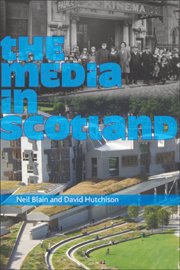Book contents
- Frontmatter
- Contents
- Preface
- Framing the Discussion
- The Historical Context
- Screen and Sound
- 7 Three Ring Circus: Television Drama about, by and for Scotland
- 8 ‘Nae Bevvying, Nae Skiving’: Language and Community in the Scottish Soap Opera
- 9 Broadcast Comedy
- 10 Contemporary Scottish Cinema
- 11 Radio and Popular Music
- Themes and Futures
- Select Bibliography
- Notes on Contributors
- Index
10 - Contemporary Scottish Cinema
from Screen and Sound
Published online by Cambridge University Press: 05 August 2013
- Frontmatter
- Contents
- Preface
- Framing the Discussion
- The Historical Context
- Screen and Sound
- 7 Three Ring Circus: Television Drama about, by and for Scotland
- 8 ‘Nae Bevvying, Nae Skiving’: Language and Community in the Scottish Soap Opera
- 9 Broadcast Comedy
- 10 Contemporary Scottish Cinema
- 11 Radio and Popular Music
- Themes and Futures
- Select Bibliography
- Notes on Contributors
- Index
Summary
In an article in the Scottish cultural magazine, The Drouth, Mark Cousins provocatively bemoaned the lack of a vibrant film culture in Scotland. Putting Iran's cinematic achievements forward as a — perhaps surprising — example, Cousins identifies several reasons for Scotland's underdevelopment, most of which revolve around a lack of experimentation and a general absence of interest in exploring the capabilities of the film form. This he puts down to the dominance of an accomplished literary tradition and the consequent development of oral culture rather than a visual alternative. Blame is also laid on various training schemes and funding initiatives espousing the rigid frameworks of mainstream film-making practices without allowing much room for new forms and practices to emerge (Cousins 2006: 12—13).
That diagnosis seems hard to accept when considering the diversity of recent films made in and about Scotland. Contemporary offerings include films skillfully working within mainstream genres but also films that push the boundaries of dominant forms and representations. However, this sort of experimentation, or even what might be called an avant-garde approach, is not necessarily a new development in Scottish cinema. On the contrary, there is a history of an avant-garde in Scottish cinema that has often been overshadowed by critical accounts and debates concerned with more dominant modes of representation. This chapter aims to reassess the development of a Scottish Art Cinema (Petrie 2000) alongside a consideration of avant-garde film-making practices.
- Type
- Chapter
- Information
- The Media in Scotland , pp. 151 - 165Publisher: Edinburgh University PressPrint publication year: 2008



